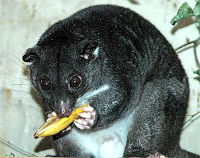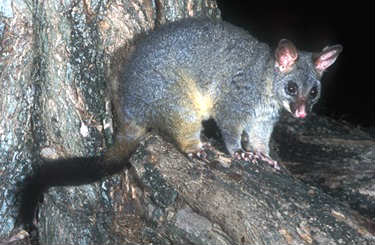Phalanger Hybrids
Family Phalangeridae
EUGENE M. MCCARTHY, PHD GENETICS
|
|

|
| Ground Cuscus |
Note: Cuscuses are eaten by humans and have likely been dispersed to many South Pacific islands when carried as a source of food on long canoe voyages. Corbet and Hill 1992 (p. 14).
Phalanger sp. [Cuscuses]
× Strigocuscus sp. [Ground Cuscuses] There has been debate whether two populations (ornatus, rothschildi) should be assigned to Phalanger or Strigocuscus. Ground Cuscuses occur on Sulawesi (S. celebensis) and in the western Moluccas (S. pelengensis) on Peleng and Taliabu. Phalangerids occur in Australia, New Guinea, the Aru Islands, and southern Moluccas. The intervening central and northern Moluccas harbor ornatus (Obi and Bisa islands) and rothschildi (Halmahera, Bacan). Given the affinity of these two populations to both Phalanger and Strigocuscus, and their geographic intermediacy, they are both PHPs of this cross. Corbet and Hill (p. 15); Feiler 1978a, 1978b; Flannery et al. 1987; Nowak 1999 (vol. 1, p. 91).
Phalanger intercastellanus [Southern Common Cuscus]
× Phalanger orientalis [Northern Common Cuscus] In a paper that split these taxa, Colgan et al. (1995) discuss the possibility that these cuscuses hybridize. They conclude that evidence for hybridization is wanting. However, they seem not to have taken samples from the contact zone since they say (p. 373) that the region of possible hybridization is “somewhere west of the Sattelberg Mission located near the eastern end of the Huon Peninsula” (eastern Papua New Guinea).
Note: Regarding Spilococus maculatus in New Guinea, Flannery (1995, p. 182) said it was as yet unknown whether the various populations treated as subspecies hybridize where their ranges meet.
Spilococus kraemeri [Admirality Cuscus]
× Spilococus maculatus [Common Spotted Cuscus] CHR. CON: Bismarck Archipelago? Kualke 1996; Singadan 1996.
Strigocuscus sp. [Ground Cuscuses] See: Phalanger sp.
 Common Brush-tail Possum
Common Brush-tail Possum(Trichosurus vulpecula)
Trichosurus arnhemensis [Northern Brush-tail Possum]
× Trichosurus vulpecula (♀) [Common Brush-tail Possum] CHR. CON: northern Northern Territory, Australia? HPF(♂&♀). These possums differ in behavior and morphology and were long treated as separate species, but were lumped by Kerle et al., in part because they were found to produce fertile hybrids in captivity. Fertility was confirmed only in males, but this suggests that females, too, should be fertile (by Haldane’s rule). Kerle 1983; Kerle et al. 1991.
Trichosurus fuliginosus [Tasmanian Brush-tail Possum]
× Trichosurus vulpecula [Common Brush-tail Possum] CHR. DRS. Hybridization in captivity is reported between two geographically disjunct types (fuliginosus, vulpecula) formerly treated as separate species, but now as races of T. vulpecula. Hope 1970; How 1972; Zoological Society of London 1861 (p. 24).
Trichosurus vulpecula [Common Brush-tail Possum]
See also: Trichosurus arnhemensis; T. fuliginosus.
× Felis catus [Domestic Cat] Please see the separate article “Possum-cat hybrids.”
× Ovis aries [Domestic Sheep] A news report in the Mudgee Guardian and North-Western Representative (Feb. 18, 1937, p. 9), entitled “A REAL FREAK: Lamb With 'Possum's Head,” reads, “Some time ago Mr. C. Cosier, senr., Curra Creek, Wellington district, had a ewe which gave birth to a freak lamb. The lamb was normal in every way and well formed, with the exception of the head. Looking from the back of the lamb no abnormality was noticeable, but on looking under the lamb's head Mr. Cosier was astounded to see a perfect opossum's head, complete with pouch and all. The lamb was, of course, dead, but it was an extraordinary freak, nevertheless.” In this context, opossum would almost certainly, refer to T. vulpecula.
By the same author: Handbook of Avian Hybrids of the World, Oxford University Press (2006).